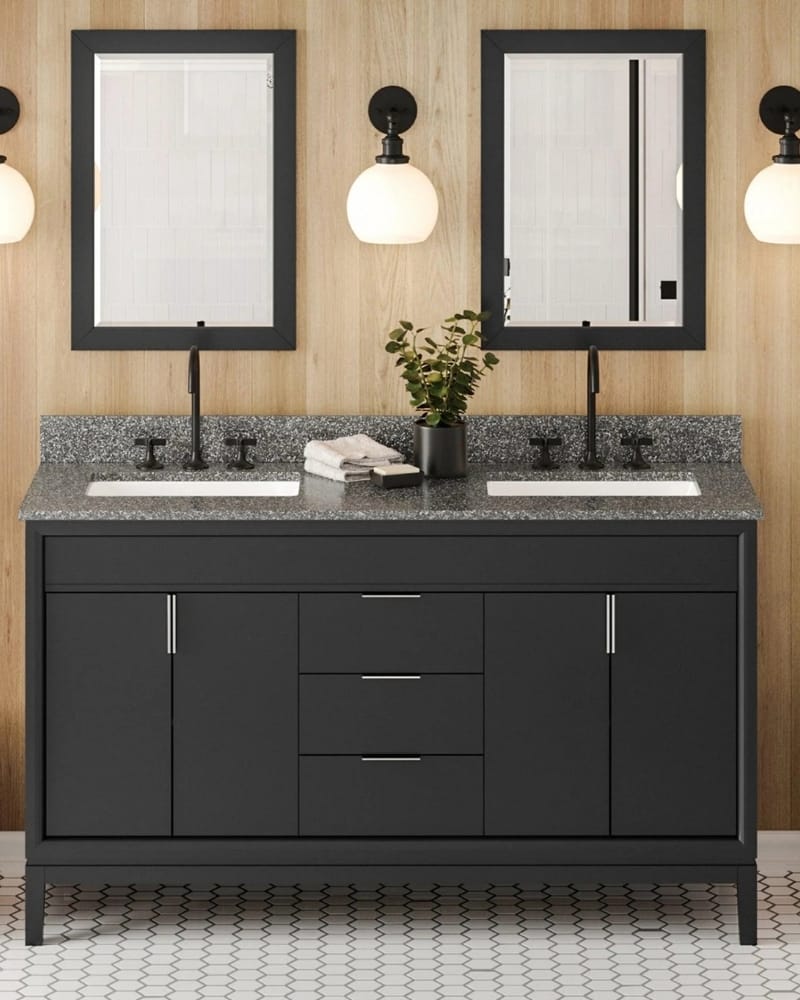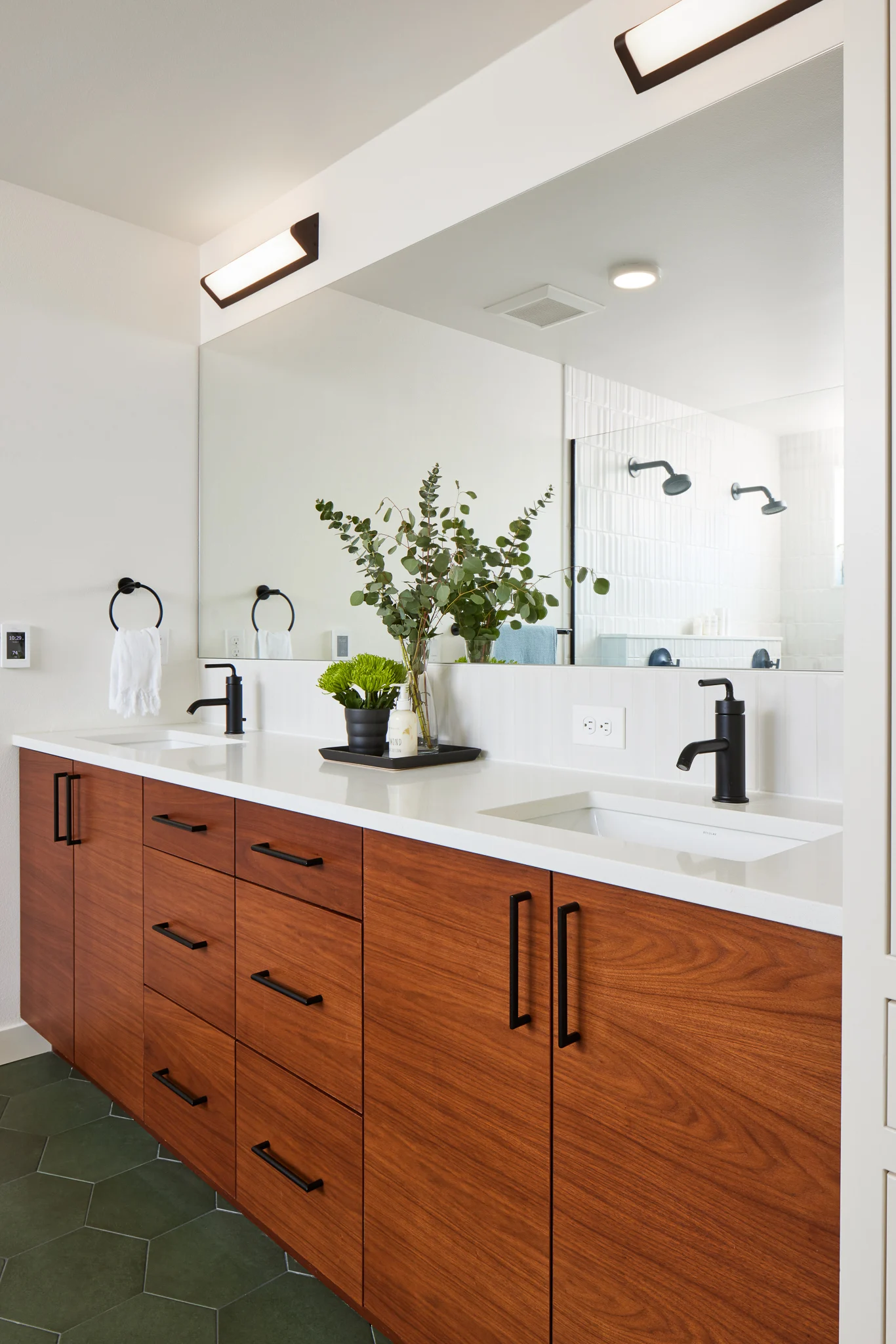Small bathrooms present unique design challenges, but the right vanities can transform cramped quarters into bright, spacious retreats. Whether you’re dealing with a powder room or a compact master bath, strategic vanity selection and placement can dramatically alter your space’s perception. Modern small bathroom vanities offer innovative solutions that maximize both functionality and visual appeal while creating the illusion of expanded square footage.
Understanding Space-Enhancing Vanity Design
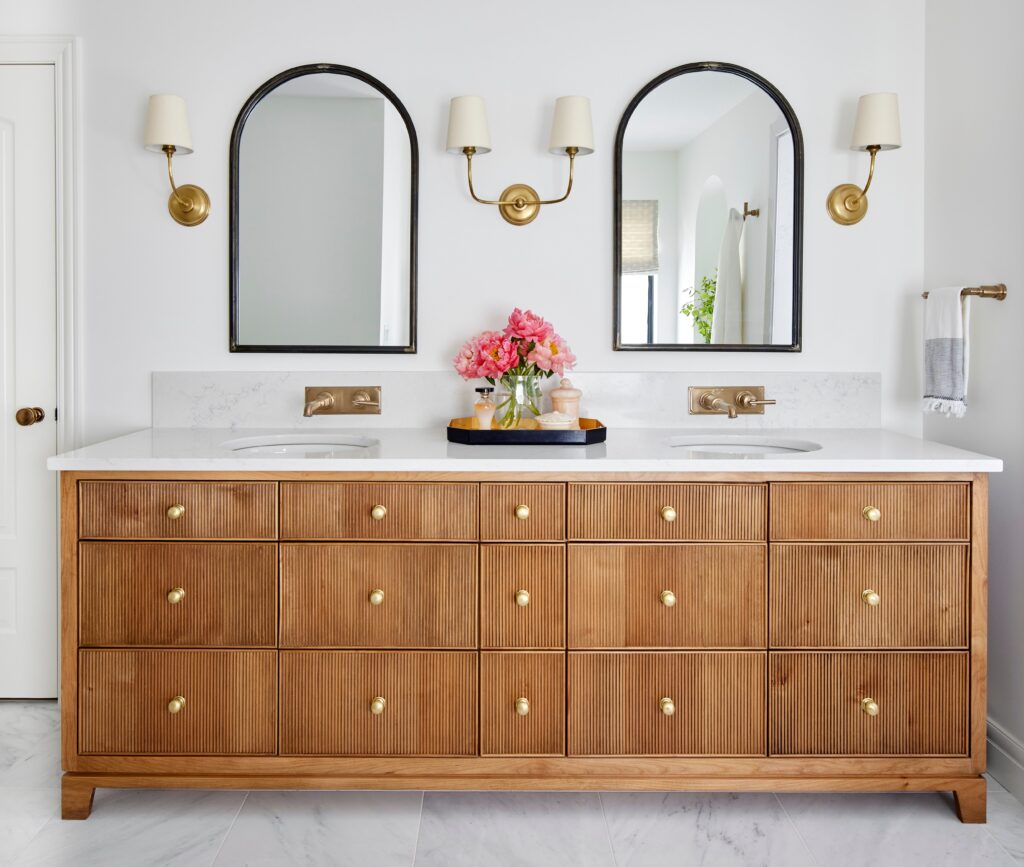
The Science Behind Visual Space Expansion
Space-saving vanities work on fundamental design principles that trick the eye into perceiving larger dimensions. Light reflection, clean lines, and strategic proportions combine to create openness where physical space is limited. The key lies in understanding how different vanity styles interact with natural and artificial light sources to enhance your bathroom’s overall brightness and perceived size.
Professional designers rely on specific ratios and measurements when selecting vanities for small spaces. A vanity that’s too large overwhelms the room, while one that’s too small can make the space feel disconnected. The ideal vanity should occupy roughly 30-40% of your bathroom’s wall space, leaving adequate room for movement while providing essential storage and functionality.
Proportional Guidelines for Small Space Vanities
When choosing bright vanities for small spaces, consider the golden ratio principle. Your vanity’s width should complement your bathroom’s dimensions without dominating the visual field. Standard depths of 18-21 inches work best for compact bathrooms, providing necessary counter space without protruding too far into walking areas.
Height considerations are equally important. Vanities mounted at 32-34 inches create a more spacious feel than standard 36-inch heights, especially when paired with large mirrors. This lower profile allows more wall space above, contributing to vertical expansion and improved light distribution throughout the room.
Design Elements That Create Openness
Contemporary vanities incorporate specific design elements that enhance spatial perception. Tapered legs, floating bases, and glass components all contribute to visual lightness. Hardware selection also impacts space perception – sleek, minimal pulls and knobs maintain clean lines while ornate hardware can make small spaces feel cluttered.
The integration of open shelving within vanity designs provides storage while maintaining visual flow. Unlike closed cabinets that create visual barriers, open shelving allows light to pass through, contributing to the overall sense of spaciousness that modern homeowners seek in their compact bathrooms.
Color Psychology and Light-Reflecting Vanities
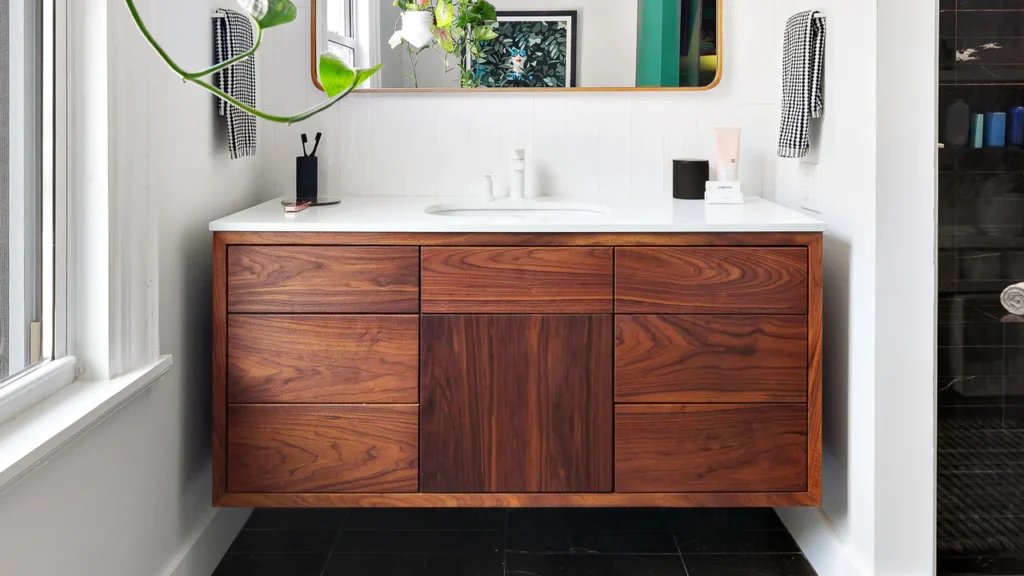
White and Light-Colored Vanity Benefits
White vanities remain the gold standard for small space enhancement due to their superior light-reflecting properties. Pure white surfaces can reflect up to 80% of available light, dramatically brightening dark corners and creating an immediate sense of expansion. This makes white vanities particularly effective in bathrooms with limited natural light sources.
Beyond pure white, soft neutrals like cream, pearl, and warm white offer similar space-enhancing benefits while adding subtle character. These lighter tones work exceptionally well with various design styles, from modern minimalist to traditional farmhouse, making them versatile choices for homeowners planning future design updates.
Light gray vanities provide an excellent middle ground, offering sophistication while maintaining brightness. Cool grays with blue undertones can make spaces feel larger and more serene, while warm grays with beige undertones create cozy yet open atmospheres. The key is selecting grays with high light reflectance values to maximize their space-enhancing potential.
Strategic Color Placement and Contrast
Effective color strategy involves more than just selecting light-colored vanities. The interplay between vanity color, wall color, and flooring creates the overall spatial impression. Monochromatic schemes using various shades of the same color family can create seamless visual flow, making boundaries less defined and spaces appear larger.
Contrast can also work effectively when used strategically. A light-colored vanity against a slightly darker wall can create depth and dimension, preventing the flat appearance that sometimes results from all-white schemes. The key is maintaining overall brightness while adding visual interest through subtle tonal variations.
Finish Selection for Maximum Light Reflection
The finish of your vanities significantly impacts light reflection and spatial perception. High-gloss finishes reflect the most light but can show fingerprints and water spots more readily. Semi-gloss finishes offer a good balance of light reflection and practicality, making them popular choices for busy family bathrooms.
Matte finishes, while trendy, absorb more light and may not be ideal for very small spaces. However, they can work well in small bathrooms with excellent natural light or when paired with strategic artificial lighting. The key is understanding your specific lighting conditions and choosing finishes that optimize available light sources.
Smart Storage Solutions in Compact Vanities

Maximizing Vertical Storage Space
Modern space-saving vanities incorporate innovative vertical storage solutions that utilize every inch of available space. Tall, narrow cabinets can extend from floor to ceiling, providing substantial storage without consuming additional floor space. These vertical elements also draw the eye upward, contributing to the perception of height and openness.
Pull-out drawers and sliding shelves within vanities maximize accessibility while maintaining organization. Deep drawers can accommodate bulky items like hair dryers and styling tools, while shallow drawers keep smaller items organized and easily accessible. This efficient organization reduces countertop clutter, maintaining the clean lines essential for small space design.
Toe-kick drawers represent an often-overlooked storage opportunity in vanities. These shallow drawers utilize the space typically left empty beneath vanity bases, providing perfect storage for flat items like bath mats, cleaning supplies, or backup toiletries. This hidden storage maintains the vanity’s clean appearance while maximizing functionality.
Integrated Organization Systems
Contemporary vanities often feature built-in organization systems that eliminate the need for additional storage accessories. Divided drawers, built-in soap dispensers, and integrated towel bars keep essentials organized while maintaining clean lines. These integrated solutions are particularly valuable in small spaces where every element must serve multiple purposes.
Adjustable shelving within vanity cabinets allows customization based on changing storage needs. This flexibility is crucial in small bathrooms where storage requirements may evolve over time. Quality vanities include adjustable components that accommodate everything from tall bottles to small containers without wasting vertical space.
Hidden storage compartments within vanities provide secure storage for valuable items while maintaining accessibility. These concealed areas can house medications, jewelry, or other personal items without compromising the vanity’s aesthetic appeal or functional efficiency.
Multi-Functional Design Features
The best small bathroom vanities incorporate multi-functional elements that serve several purposes simultaneously. Vanity tops with integrated sinks eliminate the visual break between separate components, creating cleaner lines and easier maintenance. This seamless integration is particularly effective in small spaces where visual continuity is essential.
Fold-out mirrors, retractable lighting, and hidden electrical outlets represent advanced functionality that doesn’t compromise space efficiency. These features allow small bathrooms to accommodate modern lifestyle needs without appearing cluttered or overwhelming. The key is selecting vanities that incorporate these features seamlessly into the overall design.
Built-in seating areas within larger vanities can provide functionality without requiring additional floor space. These integrated benches or stools can be tucked completely under the vanity when not in use, maintaining clear floor space while providing convenience when needed.
Wall-Mounted vs. Freestanding Vanity Options
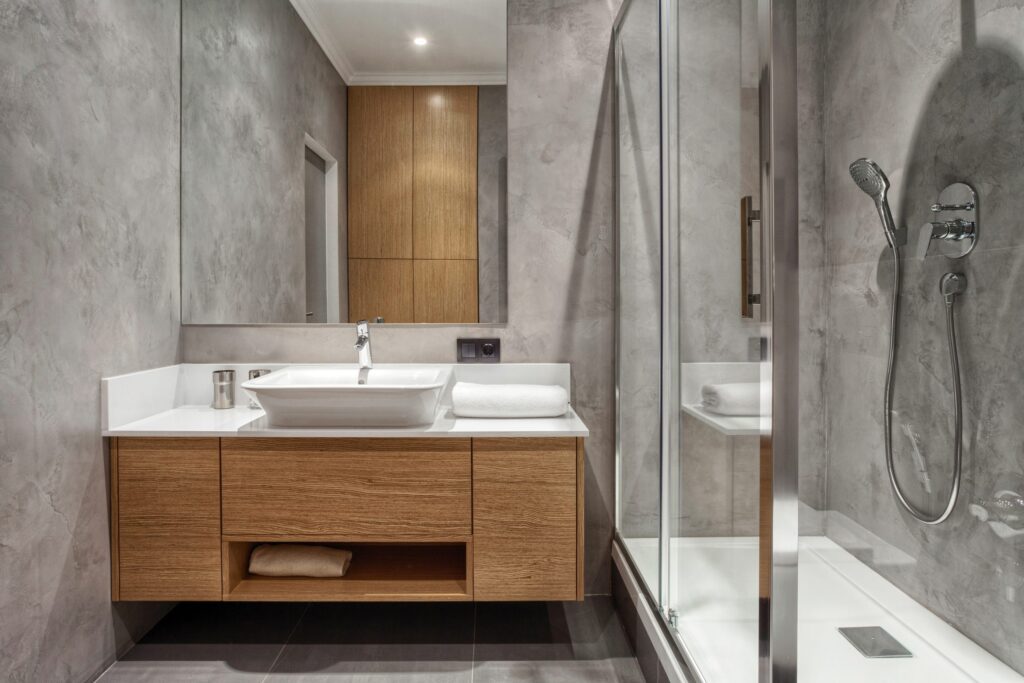
Advantages of Floating Vanities
Wall-mounted vanities create immediate visual expansion by exposing floor space beneath the unit. This floating effect makes small bathrooms appear larger while providing practical benefits like easier cleaning and improved air circulation. The continuous floor line creates an uninterrupted visual flow that enhances spatial perception.
Installation flexibility represents another significant advantage of floating vanities. These units can be mounted at custom heights to accommodate user preferences and spatial requirements. Lower mounting heights can make ceilings appear higher, while higher installations can accommodate taller users or provide additional floor storage space.
The clean, minimalist aesthetic of wall-mounted vanities complements contemporary design trends while offering timeless appeal. Without visible legs or bases, these units create sleek profiles that don’t compete with other bathroom elements for visual attention. This restraint is particularly valuable in small spaces where design simplicity is essential.
Structural Considerations for Wall Mounting
Proper installation of wall-mounted vanities requires adequate wall structure and professional expertise. Load-bearing capacity must be carefully calculated, especially for larger vanities or those made from heavy materials like natural stone. Professional installation ensures safety while maximizing the space-enhancing benefits of floating designs.
Plumbing considerations may require modifications when installing wall-mounted vanities. Supply lines and drain connections may need repositioning, and adequate access for future maintenance should be planned. These factors can impact installation costs but are essential for long-term functionality and reliability.
Wall preparation often involves reinforcement or modification to accommodate mounting hardware. Proper backing ensures secure installation while preventing future problems. Professional installers can assess existing wall conditions and make necessary modifications to support your chosen vanity safely and effectively.
When Freestanding Vanities Work Better
Traditional freestanding vanities may be preferable in certain small bathroom configurations. Rooms with uneven floors, older plumbing systems, or structural limitations may be better suited to freestanding units. These vanities can also provide additional stability for users who require support while using the vanity area.
Freestanding vanities with legs or open bases can still provide some visual expansion benefits while offering easier installation and modification. Units with tapered legs or glass bases create lightness while maintaining the structural advantages of floor-supported designs. This compromise can be ideal for renters or those planning temporary installations.
Storage capacity may favor freestanding vanities in some configurations. Floor-to-ceiling units can provide maximum storage while maintaining relatively small footprints. For households with extensive storage needs, these units may offer better functionality than their wall-mounted counterparts.
Material Choices That Maximize Light and Space

Reflective Surface Materials
Vanities constructed from high-gloss materials create maximum light reflection and spatial enhancement. Lacquered finishes, glossy laminates, and polished surfaces act as light multipliers, bouncing illumination throughout small bathrooms. These materials work particularly well in spaces with limited natural light sources.
Glass components within vanities provide transparency that maintains visual flow while offering practical functionality. Glass shelves, doors, and even entire vanity tops can create the illusion of floating elements while providing necessary storage and work surfaces. This transparency is especially effective in very small bathrooms where every visual trick counts.
Mirrored surfaces integrated into vanity designs create dramatic spatial expansion effects. Mirrored cabinet doors, drawer fronts, or even entire vanity faces can double the apparent size of small bathrooms. However, these surfaces require careful maintenance and may not suit all design preferences or practical needs.
Natural Materials That Enhance Brightness
Light-colored natural wood vanities bring warmth while maintaining brightness in small spaces. Maple, birch, and light oak offer beautiful grain patterns without overwhelming compact bathrooms. These materials can be treated with clear finishes that enhance their natural light-reflecting properties while preserving their organic character.
Natural stone materials like light-colored quartz or marble can create luxurious appearances while reflecting light effectively. These materials offer durability and timeless appeal, making them excellent long-term investments for vanities. Proper sealing ensures easy maintenance while preserving their light-enhancing properties.
Bamboo and other sustainable materials provide eco-friendly options that maintain brightness and visual lightness. These materials often feature natural light colors and interesting textures that add character without overwhelming small spaces. Their sustainability credentials also appeal to environmentally conscious homeowners.
Engineered Materials for Small Spaces
Modern engineered materials offer excellent performance characteristics for small bathroom vanities. High-quality laminates can mimic natural materials while providing superior moisture resistance and easy maintenance. These materials are available in countless colors and patterns, including options specifically designed to enhance light reflection.
Solid surface materials like Corian or similar products offer seamless integration possibilities that are particularly valuable in small spaces. These materials can be formed into complex shapes without visible joints, creating clean lines that enhance spatial perception. Their non-porous nature also provides excellent hygiene characteristics for bathroom applications.
Thermofoil and other wrapped materials provide cost-effective options that don’t compromise on appearance or performance. These materials can replicate the appearance of painted wood while offering superior moisture resistance and durability. For budget-conscious projects, these materials can provide excellent results in space-saving vanities.
Mirror Integration and Lighting Strategies
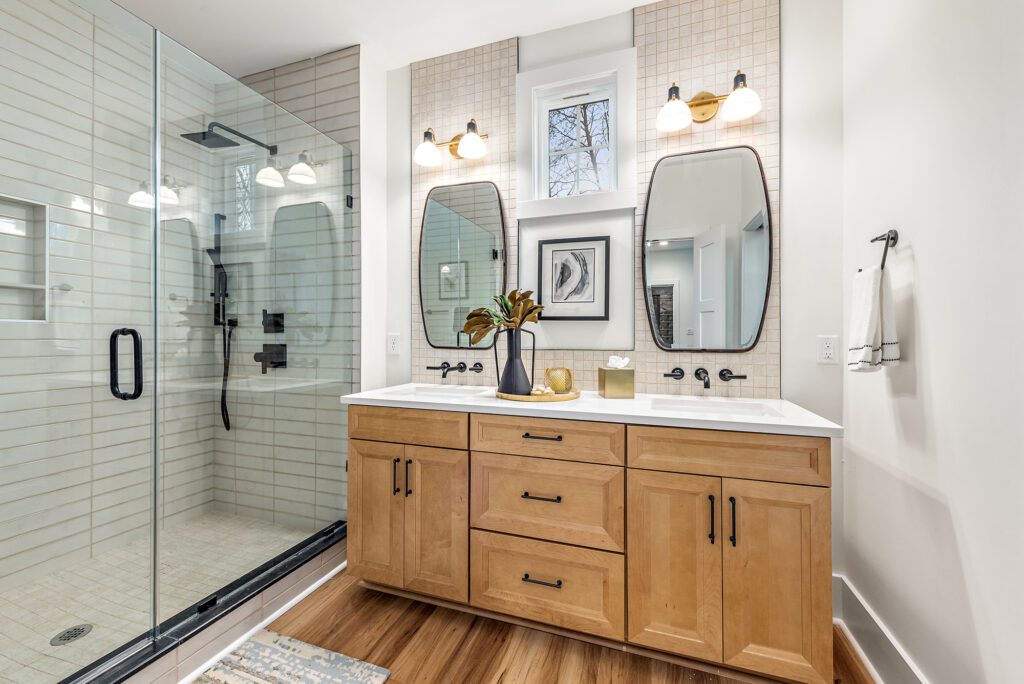
Oversized Mirrors for Maximum Impact
Large mirrors represent one of the most effective tools for expanding small bathroom spaces. When paired with well-designed vanities, oversized mirrors can create dramatic spatial illusions that transform cramped bathrooms into seemingly spacious retreats. The key is selecting mirrors that extend beyond the vanity width to maximize their space-enhancing effects.
Strategic mirror placement above vanities should consider both functional and aesthetic requirements. Mirrors positioned to reflect natural light sources can dramatically brighten dark bathrooms while creating depth and dimension. The interplay between mirror size, vanity proportions, and room dimensions requires careful consideration to achieve optimal results.
Frameless mirrors create the cleanest appearance and maximum visual expansion. Without visible boundaries, these mirrors seem to extend infinitely, contributing to spatial illusion more effectively than framed alternatives. This approach works particularly well with minimalist vanities and contemporary design schemes.
Integrated Lighting Solutions
Vanities with integrated lighting eliminate the need for separate light fixtures while providing optimal illumination for daily routines. LED strip lighting beneath floating vanities creates ambient illumination that enhances the floating effect while providing practical task lighting. This integrated approach maintains clean lines while improving functionality.
Backlit mirrors combined with well-designed vanities create sophisticated lighting schemes that enhance both function and aesthetics. These systems provide even illumination that eliminates shadows while creating dramatic visual effects. The combination of direct and indirect lighting sources creates layered illumination that makes small spaces feel larger and more luxurious.
Under-cabinet lighting within vanities provides practical task illumination while creating visual interest. These systems can highlight beautiful materials or create subtle ambient effects that enhance the overall bathroom atmosphere. Proper dimming controls allow adjustment for different times of day and various activities.
Natural Light Optimization
Positioning vanities to take advantage of natural light sources requires careful planning but can provide dramatic results. Windows positioned above or adjacent to vanities can provide excellent task lighting while creating connections to outdoor spaces. This natural illumination makes small bathrooms feel less confined and more connected to their surroundings.
Privacy considerations may require creative solutions when positioning vanities near windows. Frosted glass, window films, or strategic landscaping can provide privacy while maintaining natural light benefits. These solutions allow homeowners to enjoy natural illumination without compromising comfort or security.
Skylights or solar tubes can provide natural illumination for vanities in interior bathrooms without exterior walls. These systems bring natural light deep into homes while maintaining privacy and weather protection. The dynamic quality of natural light throughout the day creates visual interest that artificial lighting cannot replicate.
Professional Installation and Customization Tips

Planning Your Vanity Installation
Professional installation of space-saving vanities begins with careful measurement and planning. Accurate dimensions ensure proper fit while identifying potential obstacles like plumbing, electrical, or structural elements that may require modification. Professional installers can assess these factors and develop installation strategies that maximize both function and aesthetics.
Plumbing modifications often accompany vanity installations, particularly when switching between freestanding and wall-mounted units. Supply line positioning, drain connections, and shut-off valve locations may require adjustment to accommodate new vanities. Professional plumbers can ensure these modifications meet local codes while optimizing functionality.
Electrical considerations include lighting integration, outlet positioning, and switch placement. Modern vanities may require additional electrical capacity for integrated lighting, heated mirrors, or other advanced features. Professional electricians can assess existing systems and make necessary upgrades to support new installations safely.
Customization Options for Small Spaces
Custom vanities offer the ultimate solution for challenging small bathroom layouts. Professional cabinet makers can design units that maximize every inch of available space while accommodating specific storage needs and aesthetic preferences. This customization ensures optimal fit and function that mass-produced units cannot match.
Modification of existing vanities can provide cost-effective customization for budget-conscious projects. Professional installers can adjust heights, add storage components, or modify finishes to better suit specific requirements. These modifications can extend the life of existing vanities while improving their functionality and appearance.
Integration with existing bathroom elements requires professional expertise to achieve seamless results. Vanities must coordinate with flooring, wall treatments, and other fixtures to create cohesive designs. Professional designers can ensure these elements work together harmoniously while maximizing the space-enhancing benefits of well-chosen vanities.
Maintenance and Longevity Considerations
Proper maintenance ensures vanities continue to enhance small spaces for years to come. Different materials require specific care routines to maintain their appearance and functionality. Professional installation includes guidance on proper maintenance techniques that preserve both beauty and performance over time.
Quality hardware and construction details significantly impact vanity longevity. Professional-grade hinges, drawer slides, and mounting systems ensure smooth operation and extended service life. Investing in quality components during initial installation prevents premature failure and maintains the space-enhancing benefits of well-designed vanities.
Warranty considerations should influence both product selection and installation choices. Professional installation often includes warranty coverage that protects homeowners’ investments while ensuring proper function. Understanding warranty terms and requirements helps homeowners make informed decisions about their vanity investments.
FAQ
Are wall-mounted vanities better than freestanding ones for small spaces?
Wall-mounted vanities generally create more visual space by exposing floor area beneath the unit. This floating effect makes small bathrooms appear larger and easier to clean. However, freestanding units may be better for uneven floors or when maximum storage is needed. Consider your specific needs and structural limitations when choosing.
What colors make vanities look best in small bathrooms?
Light colors like white, cream, and soft gray work best for small bathroom vanities because they reflect light and create openness. White vanities can reflect up to 80% of available light, dramatically brightening dark spaces. Avoid dark colors that absorb light and make spaces feel smaller.
How much does professional vanity installation cost?
Professional installation of vanities typically ranges from $200-800 depending on complexity, location, and required modifications. Wall-mounted units may cost more due to structural requirements, while simple replacements cost less. Plumbing or electrical modifications can add $150-500 to total costs. Contact RTG Cabinet at +1 (713) 357-6373 for specific pricing.
Can I customize a vanity for my specific small bathroom layout?
Yes, custom vanities offer excellent solutions for challenging small bathroom layouts. Professional cabinet makers can design units that maximize every inch of available space while meeting your specific storage and aesthetic needs. RTG Cabinet offers custom design consultations to create perfect solutions for your space.
Transform your small bathroom into a bright, spacious retreat with the perfect vanity solution. RTG Cabinet specializes in space-enhancing vanities that combine functionality with beautiful design. Our expert team can help you select or customize the ideal vanity for your specific needs and space constraints.
Visit our Houston showroom or explore our extensive vanity collection online. Contact us at or email info@rtgcabinets.com to schedule your consultation and discover how the right vanity can transform your small bathroom into a bright, spacious sanctuary.
For additional inspiration, browse our RTG Cabinet collections featuring the Nova Series, Moda Series, and European Series, all designed to maximize both style and functionality in any space.
Source Links
- National Kitchen & Bath Association – Small Bathroom Design Guidelines – https://nkba.org/
- Houzz – Small Bathroom Vanity Ideas and Trends – https://houzz.com/
- Better Homes & Gardens – Space-Saving Bathroom Solutions – https://bhg.com/
- Architectural Digest – Small Bathroom Design Principles – https://architecturaldigest.com/
- This Old House – Bathroom Vanity Installation Guide – https://thisoldhouse.com/






